|
|
Field trip, 2nd day
Brad-Sacaramb
21th october 2003.
After having breakfast we traveled to Brad to visit
the famous goldmuseum. In the first part of the exhibition the tools
of the early ore-mining can be seen. In the next rooms are the minerals
of the gold-square exhibited, mainly gold, silver and their associate
minerals. We where glad to see, that some minerals with hungarian connection
(krennerit, nagyágit) can also be found in the collection. Here
we saw also that grown-up gold-crystal which gained the first place
for Roumania on the mineral exhibition and competition in France. An
other spectacle is the only rhombic dodecahedron gold crystal in the
world. In the last rooms of the exhibition we could see a thematic mineral
collection from all over the world.
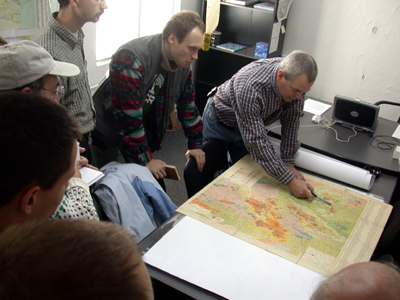
In the research centre of the Deva Gold Ltd. Certeju
de Sus, (Felsocsertés) The chiefgeologist of the company gives
a lecture about the geology of the region.
After seeing the museum we travelled to Certeju. The research-leading
chief geologist made us acquianted with the geology and the main ore-mineralization
types of the region. After the theoretical lecture we could have a look
at the rocks also on field with the explanation of the field geologist.
The huge drilling equipments where also shown us.

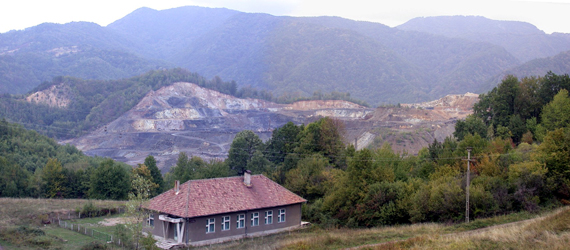
The Certeju research territory. Up to now it is worked
by the roumanian state, but if the researches go well, Deva Gold will
buy it soon.
Sitting again in the car, we drove to the historical centre of
Sacaramb. Here the mediaeval mine dumps and adits still can be seen,
and even an old mineworker has invited us to his home where he presented
us some ore minerals of the old mines. In the centre of the village
stays an obelisk in memory of the mediaeval mining. On the mine dumps
on the edge of the village we collected some beautiful minerals and
had a look at the old mining cemetary. The field trip was finished by
a group photo, and we travelled back to Deva.
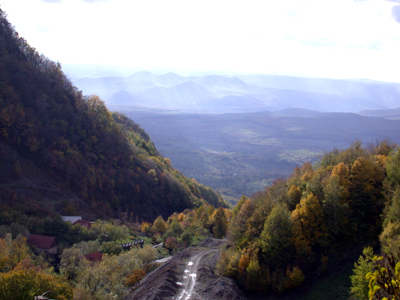
The upper end of the Sacaramb valley. In the background
is the Certeju- basin. On the other side of the basin flows the Maros
river. Behind the river the peaks of the Ruszka-mountains can be seen.
We look against S-SE..
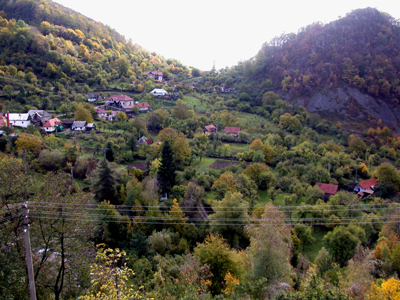
Sacaramb village is situated in a small valley surrounded
by andesite and dacite domes. This little valley is the centre of a
caldera, in which the Ag-Au telluride dykes of Sacaramb can be found.

The entrance of the Bernát adit is in the village
at 724 m.

The obelisk of the 18th century with german inscription
in memory of the mediaeval mining.
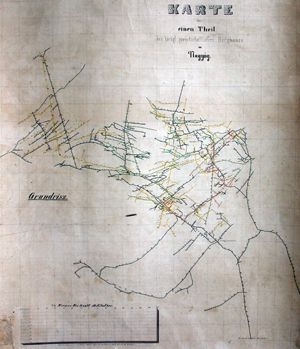
The Sacaramb mine was extracted in 11 levels between
150-787 meters height above sea level. The total length of the adits
is 100 km.
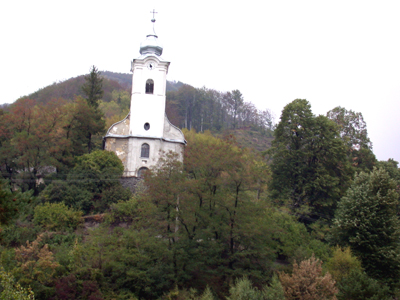
The old catholical church in Sacaramb.
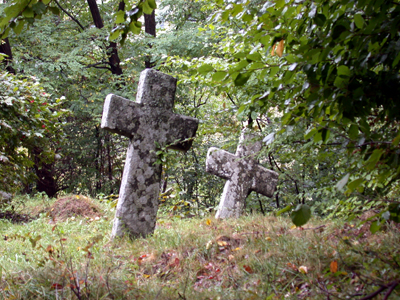
The abandoned 100-130 years old mining cemetary in the
forest.
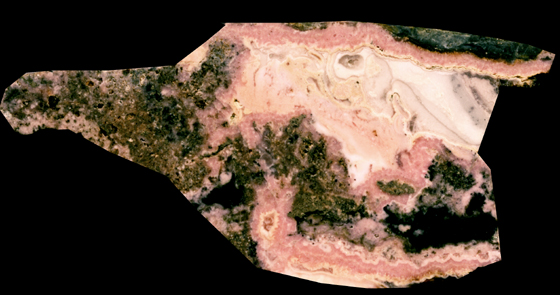
Polished carbonate veinlet with collomorphic texture.
The greenish yellow grains are pyrite, the black ones are alabandine
(MnS).

Unique orthorhombic and aggregated rhodochrosite crystals.
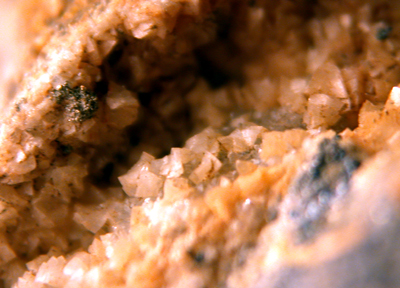
Typical saddle-shaped dolomite crystals.

Tetrahedral interpenetration twins of freibergite.
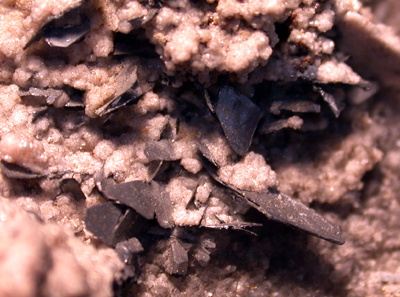
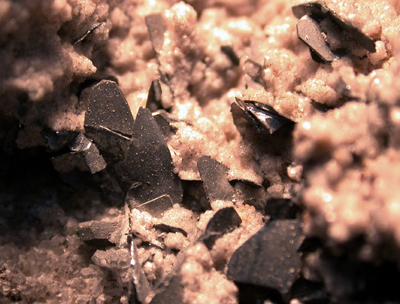
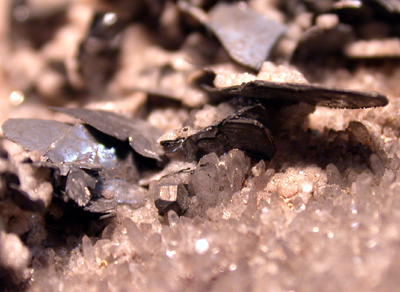
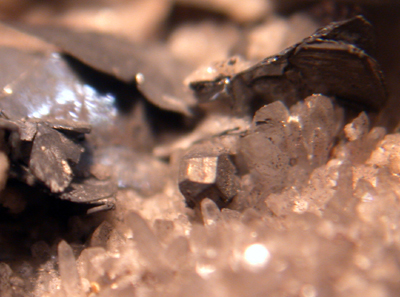
Nagyágite, Pb5Au(Te, Sb)4S5-8 , the most common
telluride in Nagyág. The sheeted (010) sylvanite (AuAgTe4) crystals
can also be seen. Width of the picture is 5 mm.
This mineral can be found in the mineral collection of the Department
of Mineralogy in the Eötvös Lóránd University.
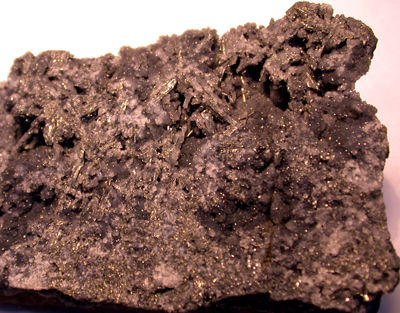

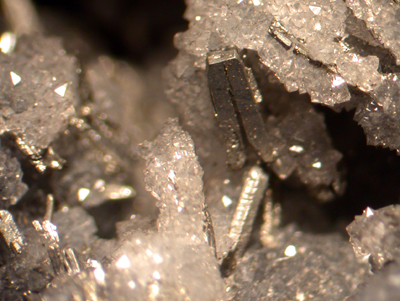
Sylvanite, AuAgTe4 is another common telluride. Its crystals
are ellongated in the direction of the b-axis and because of the similarity
to the old runic writing it is also called "writing-ore".
The picture widths change between 5mm and 5 cm. This mineral can be
found in the mineral collection of the Department of Mineralogy in the
Eötvös Lóránd University.

Altaite (white), Nagyágite (grey), Empressite
(light brown), Hessite (dark brown) (1000X, oil, 2 polars)
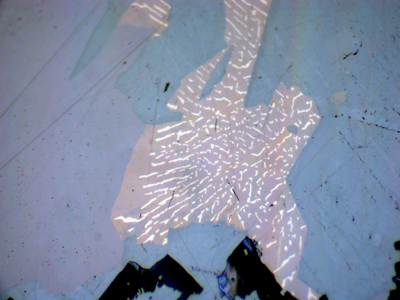
Nagyágite (blue), Empressite (dendritic, white),
Hessite (light brown) (1000X, oil, 2 polars)
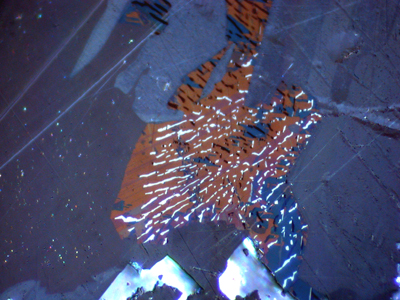
Nagyágite (blue), Empressite (dendritic, exsolved,
white), Hessite (brown) (1000X, oil, 2 polars)
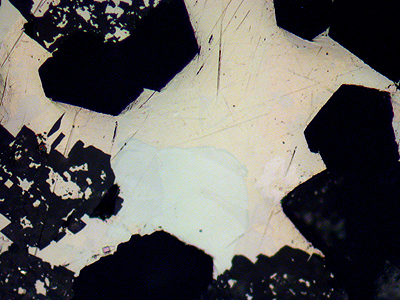
Hessite (white) (1000X, oil, 2 polars)

Hessite (blue-green-yellow) (1000X, oil +polar)
3rd day: Travelling back (Deva-Budapest)
We leaved Deva after breakfast early in the morning, and we travelled
trough Arad and Nagylak to Budapest, were we arrived in the afternoon.
Epilogue
The field trip was sponsored by the Society of Economic Geologists Student
Chapter Field Trip foundation. We thank Ferenc Molnár, the SC
sponsor of the Department of Mineralogy for the leading of the field
trip, Garry OConnor and Cecília Szentesy the chief geologist
of the Rosia Montana Gold Corporation , István Márton,
the geologist of the Deva Gold Corporation and Tibor Zelenka, the academic
SC sponsor. Special thanks to the Rosia Montana Gold Corporationnak
for the delicious diner and patience at helping the field work.

The participiants of the field trip: (from left to right) Dr. Tibor
Zelenka, András Prohászka, Cecília Szentesy, Zsófia
Wáczek, János Borsodi, (back row) Emese Gáspár,
Zsolt Benkó, Dr Ferenc Molnár, István Pári,
István Márton, (middle row from left to right) Viktor
Jáger, Attila Pogány, János Kodolányi, Dóra
Földeáki, Balázs Szinger, Anita Tóth (lower
row from left to right) Veronika Szilágyi, Ágnes Nagy,
Krisztián Szentpéteri
|
|


























